
Since OpenAI released their new chatbot software in November 2022, artificial intelligence (AI) and chatbots have been the hot topic of discussion across industries. Writers, artists and marketing professionals all wonder how the bots might eat into their work or if it will be another tool that can come alongside them and support what they do. Bard versus ChatGPT launched in full force when Google released a beta version of their own competing chatbot.
The AI Bot Battle: Bard Vs. ChatGPT
Statista estimates the global AI market for 2023 is $142.3 billion, with top-funded companies living in the chatbot sector. Two software programs you’ll hear talked about right now are Bard vs. ChatGPT.

ChatGPT comes from the artificial intelligence software company OpenAI, with backers such as Microsoft. Microsoft invested $1 billion in OpenAI in 2019 and is in negotiations to invest another $10 billion. Brains behind the company include Elon Musk, Sam Altman, Peter Thiel and Reid Hoffman.

Google’s response to Bard vs. ChatGPT was to release a beta version of their own chatbot in early 2023. Bard is quite similar to ChatGPT but the interface differs. Google has actually been in development with AI but ChatGPT’s popularity forced them to move up their timeline and go ahead and release something before OpenAI’s program ate into their share of the search engine market, since the chatbot can conduct basic research quite effectively.
While ChatGPT and Google’s Bard are not the only artificial intelligence chatbots out there, they are the two biggest players at the moment. Many smaller firms and other countries, such as China, have various AI technologies in development.
Bard vs. ChatGPT–How Do the Two Stack Up?

When it comes to Bard vs. ChatGTP, both companies have huge backing behind them. Google is one of the top search engines in the world and has powerful people and financing behind it. Although OpenAI was more unknown, it’s been around for a few years and was founded by brilliant minds in the industry and backed by Microsoft and other huge technology players.
Here at Designerly, we’ve already been playing around with ChatGPT and other OpenAI software to see what it was capable of. It’s a great tool to come alongside writers and speed up research or help with outlines. It also pulls from already created material to help writers see what’s been done to death and what would be a fresh perspective.
Imagine how thrilled we were when one of our staff members received an invite to the Bard experiment to try it out. We couldn’t wait to compare the two and see how they stacked up.
Here are the main things we noted in our Bard vs ChatGPT comparison:
1. Depth of Results
For both systems, the more detailed one can be with their language, the better. Narrowing down and focusing your request brings about better results than keeping things general.
Did you ever have a teacher in school who kept telling you to narrow your thesis statement? Think narrow, focused topics for the best results from these chatbots.
For example, we searched for: “Give me the world’s best chicken recipe.”
ChatGPT gave us a recipe for lemon herb chicken.
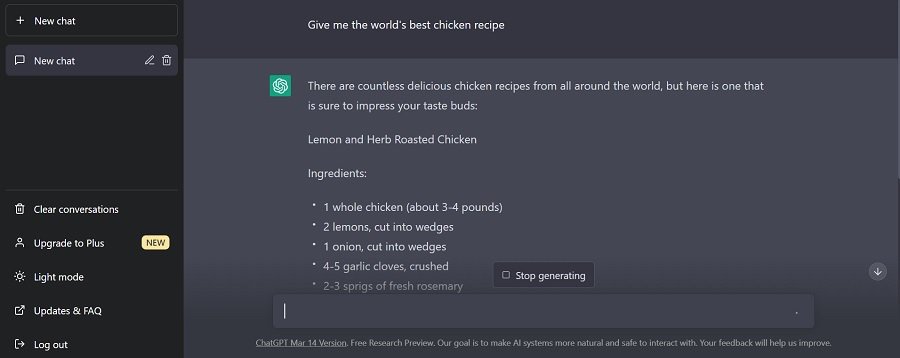
Since we’re doing a battle of Bard vs. ChatGPT-4, we also plugged the same question with the same wording into Google’s chatbot. Instead of a single best chicken recipe, we got several options without the actual recipe but one at the end for lemon chicken.

Who won the matchup? Both have pros and cons. We like the way ChatGPT keeps it simple and offers a single best chicken recipe along with complete instructions to cook it now. That said, what if you don’t like their suggestion? Bard’s option to offer additional thoughts is a good one. We can either use the recipe they provide for lemon chicken or ask a follow-up question and get a recipe for another of their ideas.
2. Generate Lists
One of the biggest benefits of ChatGPT is how it can generate ideas and lists almost effortlessly. What used to take days of brainstorming and planning can be completed in seconds. This is particularly useful for marketing teams, students and leaders who have to come up with ideas to get a session started and then build from there.
We chose to use the prompt, “Make me a list of marketing ideas to promote a new product launch for a pair of sandals.”
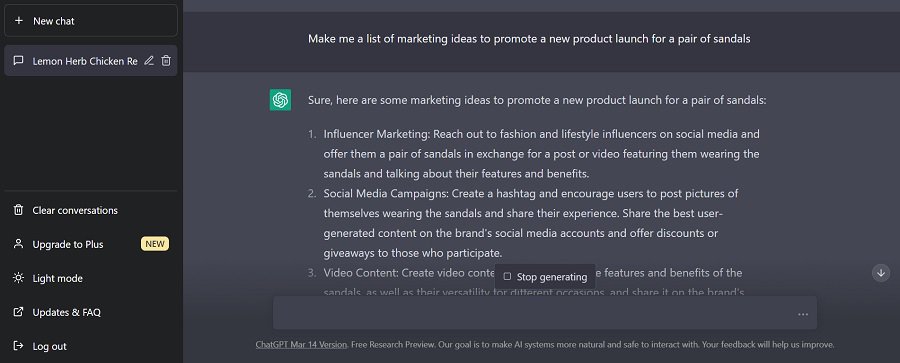
ChatGPT-4 came up with ideas for influencer marketing, social media campaigns and video content. One thing we don’t particularly like about the responses received from this chatbot is that they are rather shallow and not very specific. Note how the ideas are so general you could apply them to almost any type of product other than sandals.
Next, we asked Bard the same question.
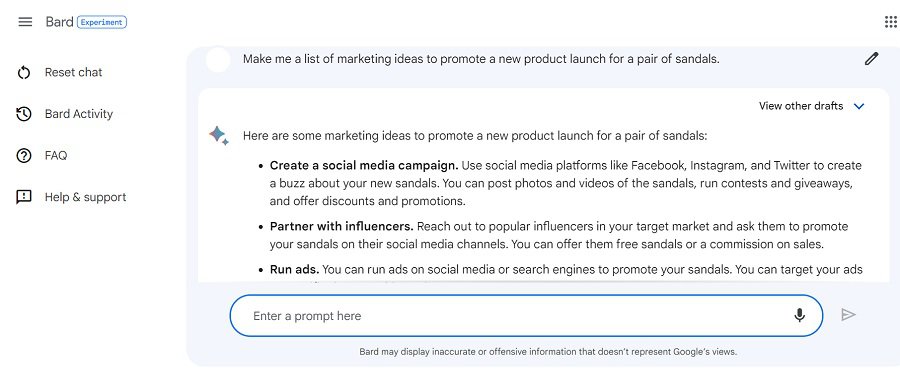
Bard offered similar results. Color us unimpressed. This is actually a perfect example of how the chatbots simply spit out general ideas they cull from the rest of mankind. It’s a computer. It can only give an idea that’s already been tried. There’s nothing unique about it that makes it stand out as brilliant. It is simply a time-saving tool that can help you come up with a general list and then expand on it from there.
The general nature of many responses is why we feel AI still has a long way to go and we aren’t worried about losing our writing or marketing jobs to a robot. It is still impossible for a machine to match the way the human brain works and likely always will be.
3. Timeliness
We wanted to see how well each generator did with current news and if it could come up with something there wasn’t a lot of outside reviews and information for. Again, while both generators didn’t do too awful, they also were very generalized with little emotion or feeling a human brings to a project.
We asked about a 2023 release by saying, “Can you summarize the book Pineapple Street by Jenny Jackson?” Staying with the order we’ve used throughout this piece, we asked ChatGPT first.
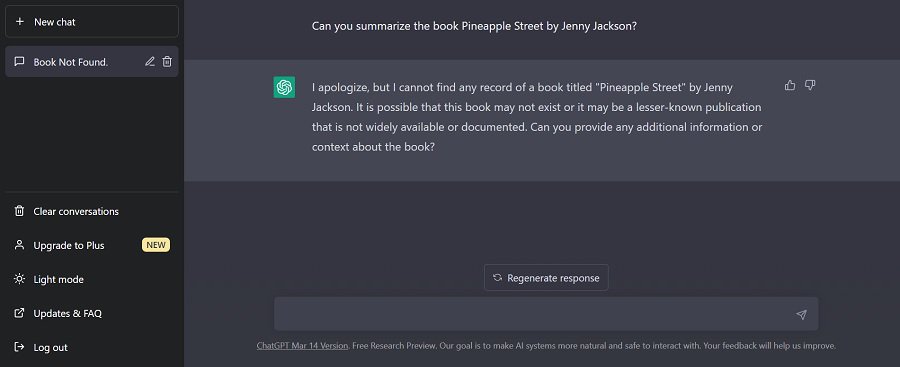
The bot couldn’t come up with any information at all. This makes us wonder if some sites already have AI generators blocked from grabbing information, such as review sites and some e-commerce stores.
Next, we turned to Google’s Bard and asked the same question.
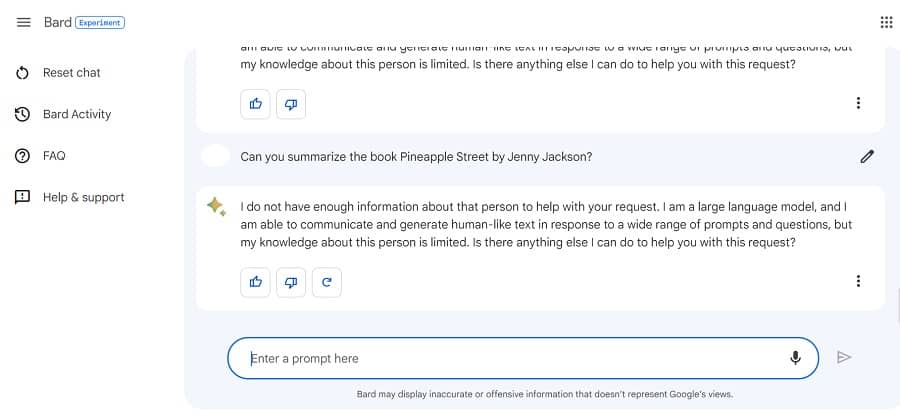
While we heard Google’s Bard might have more up-to-date information thanks to its ties to their search engine, it also couldn’t come up with a result that matched the query. However, Zapier claims Bard draws its responses in real-time and that they were able to get a summary of a popular book released in 2023 from Bard and not from ChatGPT.
Perhaps it was because we chose a more obscure fiction novel but our takeaway is that both chatbots are lacking when it comes to the most current data on some topics.
4. Interface
We find pros and cons to both interfaces. With ChatGPT, the last query appears on the left in the sidebar. You can go back to it with a quick click. You can also scroll back up. With Bard, you can scroll up or click on Bard activity in the left sidebar for a run down.
Bard gives you a bit more control to save your searches, make them private, etc. For those doing research they don’t want others to see, being able to take it private is a nice perk.
Keep in mind that Bard is still in the experimental phase and may change as users report back to Google about what’s working well for them and what isn’t. Chat-GPT will also change over time, but since it has already been released, changes may be implemented much more slowly.
5. Biases
We did test both to see what the response would be when queried with a tragedy in the headlines. Both gave somewhat politically biased responses lacking depth and ChatGPT was completely off base with the story they tapped into but which also seemed to have some biases.
We made the query more specific and soon found that ChatGPT has a severe limitation in that it stated when given a date of the incident that it could not pull info from any date prior to September 2021. The query was made in March of 2023. That means the bot runs almost 16 months behind current events.
Bard, on the other hand, pulled up the available information and even apologized for the previous response having an error. It did, however, still have some bias and left out pertinent details. Overall, we choose Bard as the winner of current events and timeliness but a bit big brotherish in limiting information to only what they wish the user to know. Since it’s a computer, we couldn’t inquire into why some details were shared and others weren’t.
As long as you’re aware of how to reduce biases in writing and stay attuned to current events and user intent, then you can still use Bard vs ChatGPT for initial research. You may have to refine your queries more or turn to other sources to round things out.
The bot itself isn’t prone to biased language, so that is a plus when using it for research or even to write an email or social media post.
6. Personality
It’s apparent both developers tried hard to give their bots personality. It falls flat. Humor is a subjective thing anyway, but try to teach a computer humor and it just doesn’t work.
We asked, “Why are you so robotic?” and got a basic answer about how natural language and machine learning work from both bots. Snore…
We then asked each to tell us a joke.
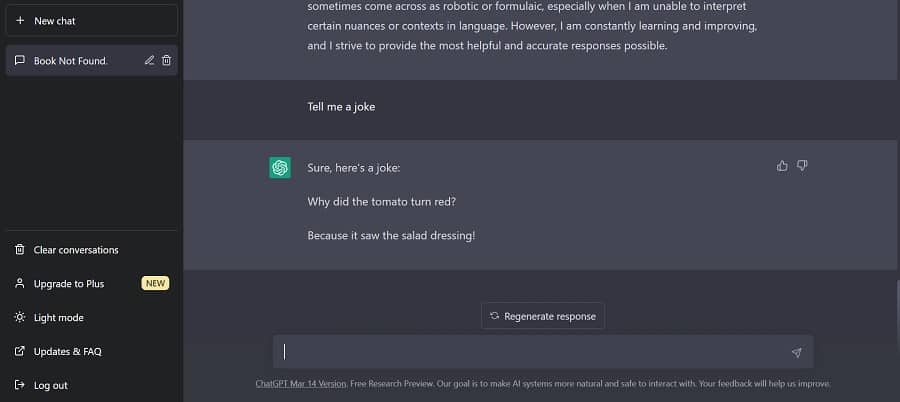
ChatGPT told us a joke that was clean and kind of cute. Sort of a dad joke style. One of those that makes you laugh in spite of yourself. Not a bad sense of humor but probably pretty rote.
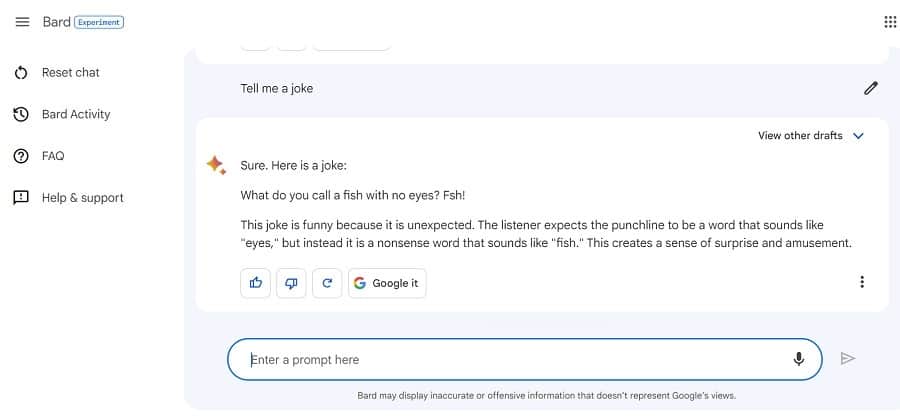
Bard told us a joke that not only fell flat about fish but they then went on and explained why the joke is funny–except it is not funny, Google. It is not.
Winner in personality goes to ChatGPT. Perhaps it is the programmer behind the AI. Perhaps it is pulling from different sources. It’s hard to say when it comes to “personality” for an inanimate thing. Nevertheless, machines still have a long way to go before they truly can offer humorous responses or show true personalities.
7. Editing Questions
We then looked at how hard it is to edit questions and dig down to get more specific results with each engine. The best way to figure this out is to ask a somewhat general question and then drill down and change it a bit.
We asked, “Are dogs allowed at the Indianapolis Zoo?”

The response from ChatGPT-4 seems to come probably right from the zoo’s website. If you needed to search several locations for details, you could save time by doing all queries from the chatbot dashboard.
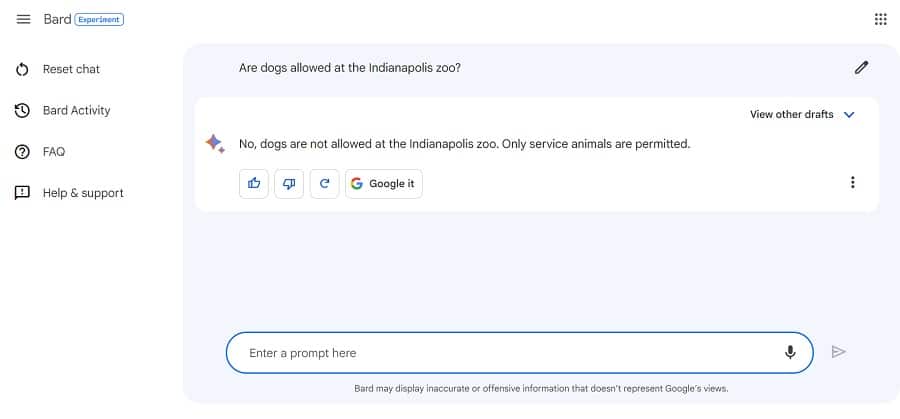
Bard gave a similar, albeit shorter, answer to the question. We then changed the question slightly to, “Are dogs allowed at the Indianapolis Zoo on any special days?”
ChatGPT-4 changed the response slightly to allow for the possibility of a special event.

We then asked Bard the same question, but one thing we like about Bard’s interface is that you can edit your initial question rather than typing a new query.

To alter your initial query or refine it a bit, just click on the edit/pencil icon next to your question. Interestingly, Google’s response to our query was different from ChatGPT’s. To our knowledge, they never allow anything other than service dogs at the zoo, so Bard was more accurate.
8. Fact-Checking
One thing we particularly like about Bard vs. ChatGPT is the way it fact-checks itself by inviting the user to “Google It” with a bright call to action (CTA) button at the bottom of each response.
You can also offer a thumbs up, thumbs down or regenerate the response. This helps the bot learn what user intent is. The idea is that with time and input the machine will improve in its abilities.
Bard vs ChatGTP: Which Is Best?
One isn’t really better than the other. They are similar in the end results, yet slightly different. Over time, one may pull ahead as the clear winner and knock the other out. Since both have such huge funding behind them, it’s unlikely Google will gobble up Bard as it has so many smaller competitors.
Our advice is to try both Bard and ChatGPT-4 and see which one you prefer. We do like the timeliness of Bard for immediacy. It is likely the best choice for research on current topics. However, ChatGPT often gives more in-depth answers and drills down to the heart of the matter. There is likely a place for both programs in most marketing and design firms.
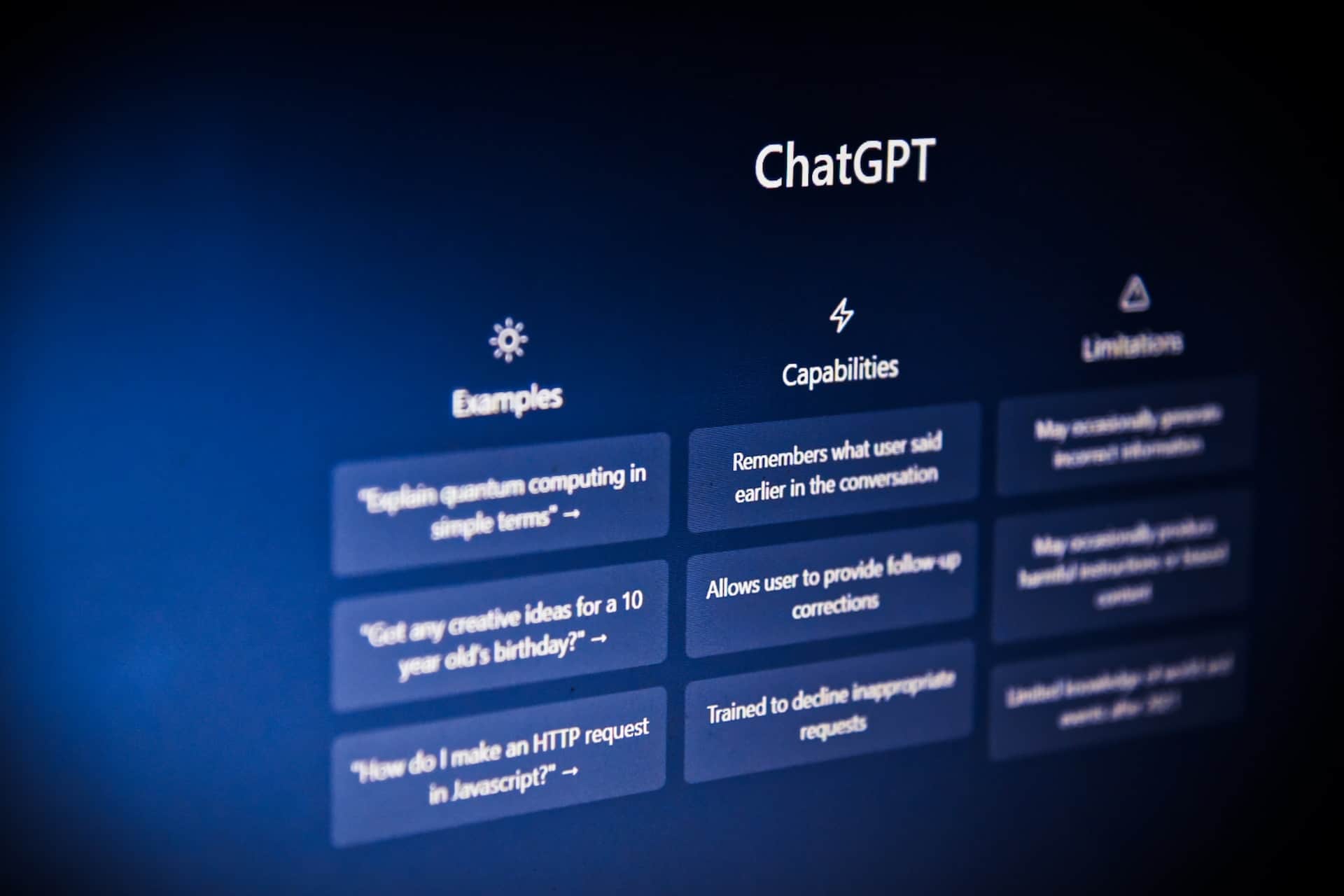



Leave a Comment